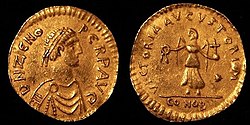Under Zeno

At the death of Leo (January 474), Strabo rebelled against the newly appointed Emperor Zeno. He killed Heraclius, the magister militum per Thracias, despite the payment of a ransom, probably because Heraclius was involved in the murder of Aspar. The support of Strabo was fundamental for the overthrowing of Zeno and the rise of Basiliscus to the Byzantine throne (475), so Basiliscus confirmed him magister militum and gave him other honours. However, Strabo was very upset when Basiliscus appointed his nephew Armatus magister militum praesentialis, because he despised him. When Zeno returned to Constantinople in 476 and defeated Basiliscus, Strabo is not reported to defend the city. [4] [5]
In 476/477, Zeno allied himself with Strabo's rival, Theodoric the Amal, and ordered him to attack Strabo. Strabo sent an embassy to the Byzantine emperor, offering peace and blaming Theodoric Amal. Zeno understood that this offering was hiding further conspiracies, and obtained that the Byzantine senate and army declare Strabo a public enemy. [4]
The plan of Zeno was to have the two Theoderics attack each other. He sent the Amal against Strabo, with the promise of a huge Roman force as renforcement (478). When Theoderic the Amal arrived through the mountains at Mount Soundis, he did not find the Roman renforcement army he expected, but Theoderic Strabo's army instead, in a strongly fortified camp. Strabo provoked the Amal, running in front of the Moesian Gothic camp and claiming that the leadership of the Amal had reduced the Goths to fighting each other, and only for the Roman gain, to have none of the wealth for which they had moved from their territories. With this speech recalling the common interest of the Goths, Strabo forced the Amal to ask for peace. The two Theodorics agreed to put forward a joint request to the Roman Emperor, in order to extend to the south the settlement territory of the Goths in Moesia. [6]

Zeno tried to divide the two Theodorics, bribing Amal, who refused to misally. The imperial army obtained some initial successes, however Zeno did not capitalize upon his victory, and allowed the Amal to move westward in Thrace, plundering the territories as he went. With the Amal far away, Strabo accepted an agreement with Zeno: Strabo was to be given back his wealth, money to pay 13,000 soldiers, the command of two palatinae units, and the title once more of magister militum. [6] However, the army of Theodoric Strabo, 30,000-men strong was still a menace for Zeno, who convinced the Bulgars to attack the Thracian Goths in their own base. Strabo defeated the Bulgars in 480/481, and moved towards Constantinople, but he had to deal with problems with his own men, so he could not capitalize upon his victory and was forced to return to Greece. On his way back, during an encampment at Stabulum Diomedis, near Philippi in Thrace, he was trying to break in an unruly horse, when he fell onto a spear hung before a tent or hanging from a wagon and died. [6] [7]